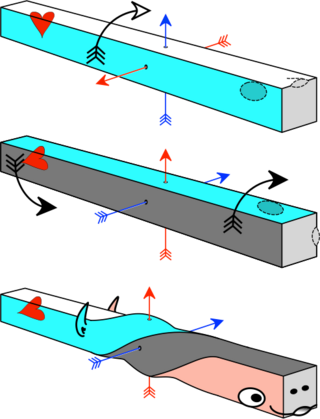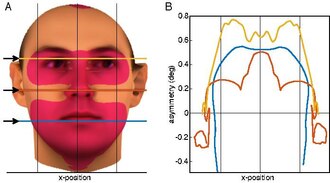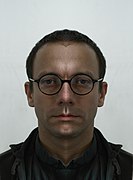
Symmetry in everyday life refers to a sense of harmonious and beautiful proportion and balance. In mathematics, the term has a more precise definition and is usually used to refer to an object that is invariant under some transformations, such as translation, reflection, rotation, or scaling. Although these two meanings of the word can sometimes be told apart, they are intricately related, and hence are discussed together in this article.

Asymmetry is the absence of, or a violation of, symmetry. Symmetry is an important property of both physical and abstract systems and it may be displayed in precise terms or in more aesthetic terms. The absence of or violation of symmetry that are either expected or desired can have important consequences for a system.
Interpersonal attraction, as a part of social psychology, is the study of the attraction between people which leads to the development of platonic or romantic relationships. It is distinct from perceptions such as physical attractiveness, and involves views of what is and what is not considered beautiful or attractive.

Physical attractiveness is the degree to which a person's physical features are considered aesthetically pleasing or beautiful. The term often implies sexual attractiveness or desirability, but can also be distinct from either. There are many factors which influence one person's attraction to another, with physical aspects being one of them. Physical attraction itself includes universal perceptions common to all human cultures such as facial symmetry, sociocultural dependent attributes, and personal preferences unique to a particular individual.

Symmetry in biology refers to the symmetry observed in organisms, including plants, animals, fungi, and bacteria. External symmetry can be easily seen by just looking at an organism. For example, the face of a human being has a plane of symmetry down its centre, or a pine cone displays a clear symmetrical spiral pattern. Internal features can also show symmetry, for example the tubes in the human body which are cylindrical and have several planes of symmetry.

Fluctuating asymmetry (FA), is a form of biological asymmetry, along with anti-symmetry and direction asymmetry. Fluctuating asymmetry refers to small, random deviations away from perfect bilateral symmetry. This deviation from perfection is thought to reflect the genetic and environmental pressures experienced throughout development, with greater pressures resulting in higher levels of asymmetry. Examples of FA in the human body include unequal sizes (asymmetry) of bilateral features in the face and body, such as left and right eyes, ears, wrists, breasts, testicles, and thighs.

An asymmetric cut is a haircut in which the hair is cut in such a way that the hair does not have left-right symmetry and one side is cut or appears to be longer than the other. It is a versatile hairstyle with many subvariations. Usually it is a combination of two separate styles, one for each side.
David Ian Perrett FBA FRSE is a professor of psychology at the University of St Andrews in Scotland, where he leads the Perception Lab. The main focus in his team's research is on face perception, including facial cues to health, effects of physiological conditions on facial appearance, and facial preferences in social settings such as trust games and mate choice. He has published over 400 peer-reviewed articles, many of which appearing in leading scientific journals such as the Proceedings of the Royal Society of London Series B—Biological Sciences, Psychological Science, and Nature.

Benedict Jones is a research psychologist and lecturer at the University of Glasgow who studies the biological and social factors underlying face perception and preferences. He received his PhD from the University of St Andrews in 2005, where he studied with David Perrett.
The psychology of art is the scientific study of cognitive and emotional processes precipitated by the sensory perception of aesthetic artefacts, such as viewing a painting or touching a sculpture. It is an emerging multidisciplinary field of inquiry, closely related to the psychology of aesthetics, including neuroaesthetics.
In physical attractiveness studies, averageness describes the physical beauty that results from averaging the facial features of people of the same gender and approximately the same age. The majority of averageness studies have focused on photographic overlay studies of human faces, in which images are morphed together. The term "average" is used strictly to denote the technical definition of the mathematical mean. An averaged face is not unremarkable, but is, in fact, quite good looking. Nor is it typical in the sense of common or frequently occurring in the population, though it appears familiar, and is typical in the sense that it is a good example of a face that is representative of the category of faces.
Odour is sensory stimulation of the olfactory membrane of the nose by a group of molecules. Certain body odours are connected to human sexual attraction. Humans can make use of body odour subconsciously to identify whether a potential mate will pass on favourable traits to their offspring. Body odour may provide significant cues about the genetic quality, health and reproductive success of a potential mate.

Yakovlevian torque is the tendency of the right side of the human brain to be warped slightly forward relative to the left and the left side of the human brain to be warped slightly backward relative to the right. This is responsible for certain asymmetries, such as how the lateral sulcus of the human brain is often longer and less curved on the left side of the brain relative to the right. Stated in another way, Yakovlevian torque can be defined by the existence of right-frontal and left-occipital petalias, which are protrusions of the surface of one hemisphere relative to the other. It is named for Paul Ivan Yakovlev (1894–1983), a Russian-American neuroanatomist from Harvard Medical School.

Chirality is a property of asymmetry important in several branches of science. The word chirality is derived from the Greek χείρ (kheir), "hand", a familiar chiral object.
Personality judgment is the process by which people perceive each other's personalities through acquisition of certain information about others, or meeting others in person. The purpose of studying personality judgment is to understand past behavior exhibited by individuals and predict future behavior. Theories concerning personality judgment focus on the accuracy of personality judgments and the effects of personality judgments on various aspects of social interactions. Determining how people judge personality is important because personality judgments often influence individuals' behaviors.
Developmental homeostasis is a process in which animals develop more or less normally, despite defective genes and deficient environments. It is an organism's ability to overcome certain circumstances in order to develop normally. This can be either a physical or mental circumstance that interferes with either a physical or mental trait. Many species have a specific norm, where those who fit that norm prosper while those who don't are killed or find it difficult to thrive. It is important that the animal be able to interact with the other group members effectively. Animals must learn their species' norms early to live a normal, successful life for that species.
Mate value is derived from Charles Darwin's theory of evolution and sexual selection, as well as the social exchange theory of relationships. Mate value is defined as the sum of traits that are perceived as desirable, representing genetic quality and/or fitness, an indication of a potential mate's reproductive success. Based on mate desirability and mate preference, mate value underpins mate selection and the formation of romantic relationships.

The axial twist theory is a scientific theory put forward to explain a range of unusual aspects of the body plan of vertebrates. It proposes that the rostral part of the head is "turned around" regarding the rest of the body. This end-part consists of the face as well as part of the brain. According to the theory, the vertebrate body has a left-handed chirality.
The ovulatory shift hypothesis holds that women experience evolutionarily adaptive changes in subconscious thoughts and behaviors related to mating during different parts of the ovulatory cycle. It suggests that what women want, in terms of men, changes throughout the menstrual cycle. Two meta-analyses published in 2014 reached opposing conclusions on whether the existing evidence was robust enough to support the prediction that women's mate preferences change across the cycle. A newer 2018 review does not show women changing the type of men they desire at different times in their fertility cycle.
















